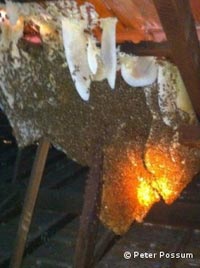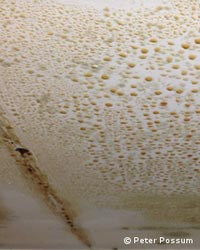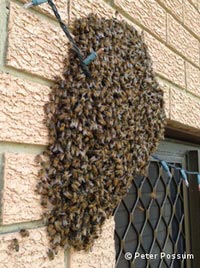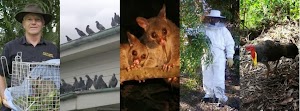If you hear humming from the walls of your home, it is possible that your home has become a haven to a bee hive and you need to get a bee removal specialist as soon as possible.

A massive bee hive in a ceiling space
There are two main types of bees that move into homes in Brisbane – Escapes from commercial Honeybee hives and Social Native Bees.
Feral commercial honeybees are approximately 12mm long, the traditional black/dark brown and yellow/orange colour, and they can sting. Social native bees are only about 4mm long, black and are unable to sting; they do have a spike on their legs and strong chewing plates in their mouths, so you might think you have been stung.
Traditional Honey bee behaviour is that when a bee hive becomes too large, approximately half of the hive leaves with the old queen to seek a new home. This is called swarming. Scouts leave the swarm to seek out safe cavities to form a new nest.
Human homes provide attractive cavities with our walls and roofs. Gaps such as weep holes create access to wall cavities and roof cavities which are perfect homes for bees.

Honey from a hive dripping through a ceiling
When bees cause a problem in a house wall it is usually the larger swarms of feral honeybees.
When honey bees move in, they first build comb cells and start to fill them with nectar (honey) and pollen, while the Queen gets on with laying eggs and rearing new bees. It takes 3 days for the eggs to hatch into larvae and then 9 days later to become pupae and then adult bees. The average bee life cycle is 21 days.
An average honey bee swarm has approximately 10,000 bees, while an established hive can have up to 50,000 bees. These hives will take up a large amount of space within a home. We have had them covering a 3 metre wide area within a wall, and within a roof area we have seen hives 1 metre wide and 1 metre deep.

A bee swarm resting on a house wall
Hives inside a building need to be treated as soon as they are spotted to reduce the chance of the bees stinging people walking past. It’s also important to stop them creating a large hive into your home because it can result in honey leaking from walls and ceilings.
After we have done a bee swarm removal, we can then quote to remove the bee hive if required, as the smell of abandoned or empty hives may attract new colonies to your home. In addition, the abandoned honey comb can begin to leak honey during summer as the wax of the combs melts. With established hives, these honey leaks can ooze through your ceiling and walls requiring large areas of the plasterboard to be replaced.
The Possum Man can remove Honey bees and relocate native bees from your home. We can also provide a quote to cut your wall or ceiling, and remove the hive and honey from your home. If your walls are humming – call us!







